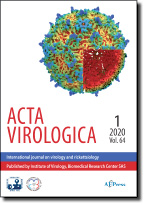Acta Virologica Vol.63, No.3, p.292-300, 2019
|
| Title: Secondary dengue infection in immunocompetent murine model leads to heart tissue damage |
| Author: F. C. JÁCOME, A. L. TEIXEIRA DE ALMEIDA, D. D. COUTINHO DE SOUZA, A. DA COSTA RASINHAS, G. C. CALDAS, M. A. NUNES DA SILVA, O. M. BARTH, D. F. BARRETO-VIEIRA |
|
Abstract: Dengue, considered the most important arthropod-borne viral disease affecting humans, is transmitted by the bite of mosquitoes of the genus Aedes and caused by one of the four distinct serotypes of dengue virus (DENV-1, -2, -3 and -4). Infection with one of the four serotypes provides lifelong homotypic immunity. However, immunity against the heterologous serotypes is transient. As a consequence, secondary infection may lead to severer manifestations due to cross-reactivity of antibodies and T-cells. Over 500,000 people are hospitalized every year and around 2,5 million, living in endemic areas, are at risk of infection. Given the background, the development of vaccines and anti-DENV drugs is of the utmost importance, as is the characterization of an animal model for testing them. The purpose of this study was to investigate ultrastructural alterations caused by DENV secondary infection in BALB/c mice heart. To achieve our goal, six BALB/c mice were infected with DENV-1 and, 4 months later, reinfected with DENV-2. Uninfected mice were used as negative controls. Heart samples were collected and processed for ultrastructural and histopathological analysis. Our results showed edema, endothelium activation characterized by the presence of transport vesicles, free platelets in interstitium, mitochondria presenting rarefied matrix and degenerated cristae, and disorganization of muscle fibers. These results point not only to BALB/c mice susceptibility to DENV infection, but also to the fact that, although it is not an often reported occurrence, dengue can lead to heart damage.
|
|
| Keywords: dengue; experimental model; reinfection; BALB/c mice |
|
|
|
| Year: 2019, Volume: 63, Issue: 3 |
Page From: 292, Page To: 300 |
doi:10.4149/av_2019_309
|
|
 download file download file |
|
|
|
|
 download file
download file
